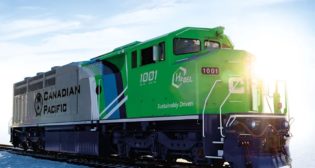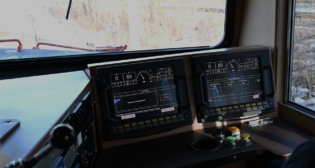
Supply Side: FreightCar America, Rail Vision
FreightCar America marks a milestone with the 10,000th railcar produced at its Mexico plant. Also, Rail Vision Ltd. receives a follow-on order from a U.S.-based rail and leasing services company.

FreightCar America marks a milestone with the 10,000th railcar produced at its Mexico plant. Also, Rail Vision Ltd. receives a follow-on order from a U.S.-based rail and leasing services company.
![According to Rail Vision, its Shunting Yard System “automatically detects and classifies objects within a range of 200 meters [656 feet]—in any weather or light conditions.” (Image Courtesy of Rail Vision)](https://www.railwayage.com/wp-content/uploads/2024/06/Screenshot-2024-06-11-at-4.16.13-PM-1-315x168.png)
Track maintenance equipment and services provider Loram takes delivery of Rail Vision Ltd.’s monitoring and obstacle detection system for yards. Also, Wabtec Corporation achieves ISO 27001 certification; and Eco-Energy, LLC partners with Commtrex to deliver outsourced logistics and fleet management services throughout North America.
![According to Rail Vision, its ShuntingYard system “automatically detects and classifies objects within a range of 200 meters [218 yards]—in any weather or light conditions.” (Image Courtesy of Rail Vision)](https://www.railwayage.com/wp-content/uploads/2024/06/Screenshot-2024-06-11-at-4.16.13-PM-315x168.png)
A U.S. Class I railroad has taken delivery of Rail Vision Ltd.’s monitoring and obstacle detection system for yards. Also, Wabtec Corporation’s Green Friction braking system will be deployed on RER A line trains operating in the Paris, France, metropolitan area.

Rail Vision Ltd. receives a U.S. patent notice of allowance for its AI (Artificial Intelligence)-based railway obstacle detection system. Also, North American Rail Solutions acquires Strategic Rail, LLC in Tomahawk, Wis.

Ra’anana, Israel-based Rail Vision Ltd. on April 15 announced that, as part of its marketing efforts in the U.S., it has entered into a non-binding Memorandum of Understanding (MOD) with an undisclosed leading railway technologies company for the distribution of its MainLine and ShuntingYard products.

Ra’anana, Israel-based Rail Vision Ltd. on March 18 reported entering into a non-binding memorandum of understanding with a railway technologies company in the United States for the distribution of its Main Line and

Ballard Power Systems (Ballard) receives an order of additional fuel cell engines from Canadian Pacific Kansas City (CPKC). Also, Rail Vision ltd. (Rail Vision) reveals its next-generation AI (Artificial Intelligence) computer for railway safety and accident prevention and is granted a patent approval from the Indian Patent Office.

Wabtec’s Trip Optimizer energy-management software tops 1 billion miles of operation. Also, Rail Vision Ltd. lands a switch-yard systems contract from a U.S.-based rail and leasing services company.

Israel-based technology company Rail Vision Ltd. (Rail Vision) announced Jan. 9 that it has established a $6 million credit facility and an additional amount of up to $3 million, subject to certain conditions, with a global investment firm.

Between 2013 and 2022, more than 12,000 incidents occurred on the nation’s 140,000 miles of track. Though the railway industry has accurately asserted significant safety improvements over the past decade, and though